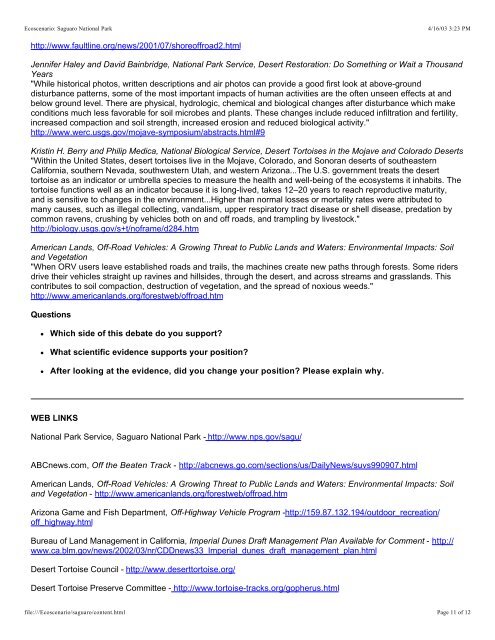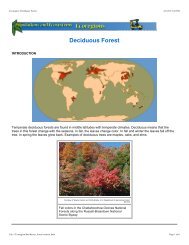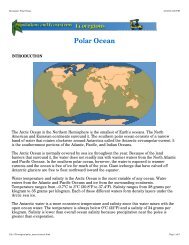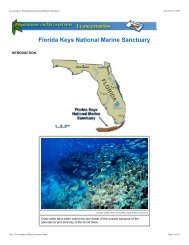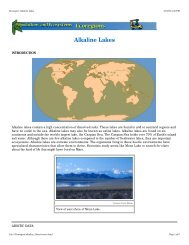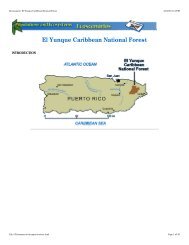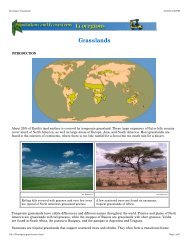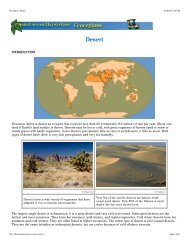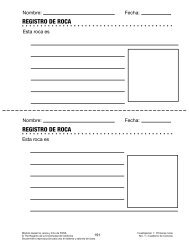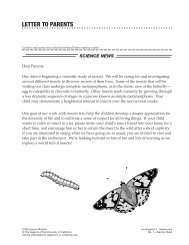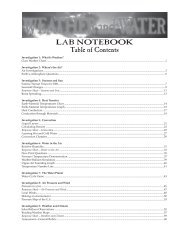Ecoscenarios Combined - FOSSweb
Ecoscenarios Combined - FOSSweb
Ecoscenarios Combined - FOSSweb
You also want an ePaper? Increase the reach of your titles
YUMPU automatically turns print PDFs into web optimized ePapers that Google loves.
Ecoscenario: Saguaro National Park<br />
4/16/03 3:23 PM<br />
http://www.faultline.org/news/2001/07/shoreoffroad2.html<br />
Jennifer Haley and David Bainbridge, National Park Service, Desert Restoration: Do Something or Wait a Thousand<br />
Years<br />
"While historical photos, written descriptions and air photos can provide a good first look at above-ground<br />
disturbance patterns, some of the most important impacts of human activities are the often unseen effects at and<br />
below ground level. There are physical, hydrologic, chemical and biological changes after disturbance which make<br />
conditions much less favorable for soil microbes and plants. These changes include reduced infiltration and fertility,<br />
increased compaction and soil strength, increased erosion and reduced biological activity."<br />
http://www.werc.usgs.gov/mojave-symposium/abstracts.html#9<br />
Kristin H. Berry and Philip Medica, National Biological Service, Desert Tortoises in the Mojave and Colorado Deserts<br />
"Within the United States, desert tortoises live in the Mojave, Colorado, and Sonoran deserts of southeastern<br />
California, southern Nevada, southwestern Utah, and western Arizona...The U.S. government treats the desert<br />
tortoise as an indicator or umbrella species to measure the health and well-being of the ecosystems it inhabits. The<br />
tortoise functions well as an indicator because it is long-lived, takes 12–20 years to reach reproductive maturity,<br />
and is sensitive to changes in the environment...Higher than normal losses or mortality rates were attributed to<br />
many causes, such as illegal collecting, vandalism, upper respiratory tract disease or shell disease, predation by<br />
common ravens, crushing by vehicles both on and off roads, and trampling by livestock."<br />
http://biology.usgs.gov/s+t/noframe/d284.htm<br />
American Lands, Off-Road Vehicles: A Growing Threat to Public Lands and Waters: Environmental Impacts: Soil<br />
and Vegetation<br />
"When ORV users leave established roads and trails, the machines create new paths through forests. Some riders<br />
drive their vehicles straight up ravines and hillsides, through the desert, and across streams and grasslands. This<br />
contributes to soil compaction, destruction of vegetation, and the spread of noxious weeds."<br />
http://www.americanlands.org/forestweb/offroad.htm<br />
Questions<br />
Which side of this debate do you support?<br />
What scientific evidence supports your position?<br />
After looking at the evidence, did you change your position? Please explain why.<br />
WEB LINKS<br />
National Park Service, Saguaro National Park - http://www.nps.gov/sagu/<br />
ABCnews.com, Off the Beaten Track -<br />
http://abcnews.go.com/sections/us/DailyNews/suvs990907.html<br />
American Lands, Off-Road Vehicles: A Growing Threat to Public Lands and Waters: Environmental Impacts: Soil<br />
and Vegetation - http://www.americanlands.org/forestweb/offroad.htm<br />
Arizona Game and Fish Department, Off-Highway Vehicle Program -http://159.87.132.194/outdoor_recreation/<br />
off_highway.html<br />
Bureau of Land Management in California, Imperial Dunes Draft Management Plan Available for Comment - http://<br />
www.ca.blm.gov/news/2002/03/nr/CDDnews33_Imperial_dunes_draft_management_plan.html<br />
Desert Tortoise Council - http://www.deserttortoise.org/<br />
Desert Tortoise Preserve Committee - http://www.tortoise-tracks.org/gopherus.html<br />
file:///Ecoscenario/saguaro/content.html<br />
Page 11 of 12


